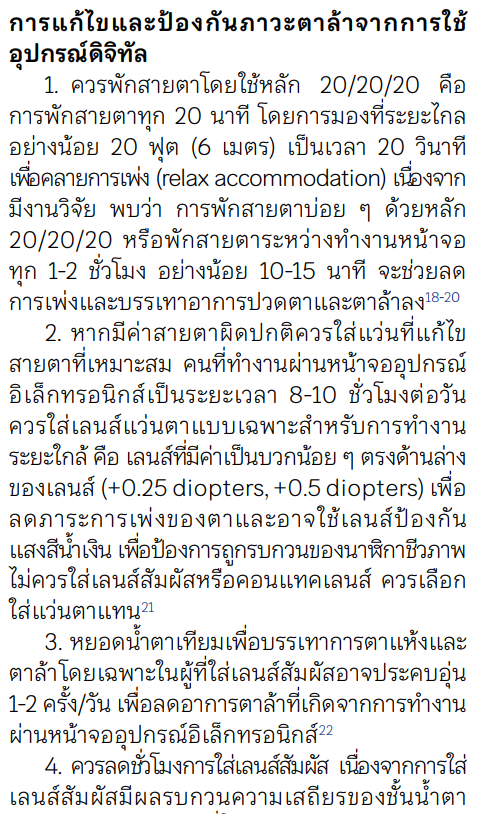Digital eye strain in the COVID-19 era
Keywords:
Digital eye strain, Covid-19Abstract
The epidemic situation of Covid-19 since late 2019 until present is a situation that develops so rapidly and severely that the disease spreads in many countries causing countless damages around the world. People need to modify their lifestyles differently from their original living. This adjustment creates new inventions and also bring new technology to apply in many aspects of living such as education, communication, business, and work. The new normal of working from home generate a more frequent and a longer duration of using an electronic media by most people resulting in eye strain, which has symptoms of blurry vision, double vision, abnormal focus (accommodation dysfunction), dry eye, eye fatigue, burning sensation and tearing. With the increasing of digital eye strain, the ophthalmic healthcare providers including ophthalmologists, optometrists, and ophthalmic practitioners should be able to advise people on the cause, management and prevention of eye strain from using electronic devices. With a good understanding and awareness about digital eye strain, this knowledge will help people to have good eye health and prevent the eye strain in the digital era.
Downloads
References
Hall L, Brennan-Coles C. More screen time= more digital eye strain. Contact Lens Spectrum. 2015;30:38-40. https://doi.org/10.1016/j.clae.2014.11.085
TR A, Mashalla Y. Impact of Computer Technology on Health: Computer Vision Syndrome (CVS). Medical Practice Review. 2014;5:20-30. https://doi.org/10.5897/MPR
Arif KM, Alam MJ. Computer Vision Syndrome. Faridpur Medical College Journal. 2015; 10(1):33-35. https://doi.org/10.3329/fmcj.v10i1.27923
Loh K, Redd S. Understanding and preventing computer vision syndrome. Malays Fam Physician. 2008;3(3):128-130.
Rosenfield M. Computer vision syndrome: a review of ocular causes and potential treatments. Ophthalmic Physiol Opt. 2011;31(5):502–515. https://doi.org/10.1111/j.1475-1313.2011.00834.x PMid:21480937
Ide T, Toda I, Miki E, Tsubota K. Effect of Blue Light-Reducing Eye Glasses on Critical Flicker Frequency. Asia Pac J Ophthalmol (Phila). 2015;4(2):80-85. https://doi.org/10.1097/APO.0000000000000069 PMid:26065349
Thorud HM, Helland M, Aarås A, Kvikstad TM, Lindberg LG, Horgen G. Eye-related pain induced by visually demanding computer work. Optom Vis Sci. 2012;89(4): E452-E464. https://doi.org/10.1097/OPX.0b013e31824c1801 PMid:22366711
Wiggins NP, Daum KM. Visual discomfort and astigmatic refractive errors in VDT use. J Am Optom Assoc. 1991;62(9):680-684.
Patel S, Henderson R, Bradley L, Galloway B, Hunter L. Effect of visual display unit use on blink rate and tear stability. Optom Vis Sci. 1991;68(11):888-892. https://doi.org/10.1097/00006324-199111000-00010 PMid:1766652
Jansen ME, Begley CG, Himebaugh NH, Port NL. Effect of contact lens wear and a near task on tear film break-up. Optom Vis Sci. 2010;87(5):350-357. https://doi.org/10.1097/OPX.0b013e3181d951df PMid:20351601
Tosha C, Borsting E, Ridder WH 3rd, Chase C. Accommodation response and visual discomfort. Ophthalmic Physiol Opt. 2009;29(6):625-633 https://doi.org/10.1111/j.1475-1313.2009.00687.x
PMid:19821926
Sheedy JE, Parsons SD. The Video Display Terminal Eye Clinic: clinical report. Optom Vis Sci. 1990;67(8):622-626. https://doi.org/10.1097/00006324-199008000-00012 PMid:2216330
Read SA, Vincent SJ, Collins MJ. The visual and functional impacts of astigmatism and its clinical management. Ophthalmic Physiol Opt. 2014;34(3):267-294. https://doi.org/10.1111/opo.12128 PMid:24635572
Bahkir FA, Grandee SS. Impact of the COVID-19 lockdown on digital device-related ocular health. Indian J Ophthalmol. 2020; 68(11):2378-2383.d https://doi.org/10.4103/ijo.IJO_2306_20 PMid:33120622 PMCid:PMC7774196
Patil A, Bhavya, Chaudhury S, Srivastava S. Eyeing computer vision syndrome: Awareness, knowledge, and its impact on sleep quality among medical students. Ind Psychiatry J. 2019;28(1):68-74.
https://doi.org/10.4103/ipj.ipj_93_18 PMid:31879450 PMCid:PMC6929228
Chang AM, Aeschbach D, Duffy JF, Czeisler CA. Evening use of light-emitting eReaders negatively affects sleep, circadian timing, and next-morning alertness. Proc Natl Acad Sci U S A. 2015;112(4):1232-1237. https://doi.org/10.1073/pnas.1418490112 PMid:25535358 PMCid:PMC4313820
Rosenfield M. Computer vision syndrome (a.k.a. digital eye strain). Optometry in practice. 2016;17:1-10.
Anggrainy P, Lubis R, Ashar T. The effect of trick intervention 20-20-20 on computer vision syndrome incidence in computer workers. Oftalmologicheskii Zhurnal. 2020;84:22-27. https://doi.org/10.31288/oftalmolzh202012227
Tribley J, McClain S, Karbasi A, Kaldenberg J. Tips for computer vision syndrome relief and prevention. Work. 2011;39(1):85-87. https://doi.org/10.3233/WOR-2011-1183 PMid:21673432
Fenety A, Walker JM. Short-term effects of workstation exercises on musculoskeletal discomfort and postural changes in seated video display unit workers. Phys Ther. 2002; 82(6):578-589. https://doi.org/10.1093/ptj/82.6.578 PMid:12036399
Butzon SP, Sheedy JE, Nilsen E. The efficacy of computer glasses in reduction of computer worker symptoms. Optometry. 2002;73(4): 221-230.
Guillon M, Maissa C, Pouliquen P, Delval L. Effect of povidone 2% preservative-free eyedrops on contact lens wearers with computer visual syndrome: pilot study. Eye Contact Lens. 2004;30(1):34-39. https://doi.org/10.1097/01.ICL.0000101489.13687.9A PMid:14722467
Chalmers RL, Begley CG. Dryness symptoms among an unselected clinical population with and without contact lens wear. Cont Lens Anterior Eye. 2006;29(1): 25-30. https://doi.org/10.1016/j.clae.2005.12.004 PMid:16448840
Bababekova Y, Rosenfield M, Hue JE, Huang RR. Font size and viewing distance of handheld smart phones. Optom Vis Sci. 2011;88(7):795-797. https://doi.org/10.1097/OPX.0b013e3182198792 PMid:21499163

Downloads
Published
How to Cite
Issue
Section
License
Copyright (c) 2023 Chulabhorn Royal Academy

This work is licensed under a Creative Commons Attribution-NonCommercial-NoDerivatives 4.0 International License.
Copyright and Disclaimer
Articles published in this journal are the copyright of Chulabhorn Royal Academy.
The opinions expressed in each article are those of the individual authors and do not necessarily reflect the views of Chulabhorn Royal Academy or any other faculty members of the Academy. The authors are fully responsible for all content in their respective articles. In the event of any errors or inaccuracies, the responsibility lies solely with the individual authors.


